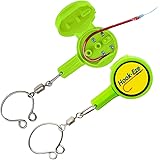Are you ready to take your bass fishing game to the next level? Look no further! In this ultimate guide, we’ll cover everything you need to know about catching big bass. From choosing the best lures to finding the perfect spot and using the right equipment, we have all the tips and tricks you need for a successful day on the water. Let’s get started!
Best Lures for Bass Fishing:
When it comes to bass fishing, there are many different types of lures that can be used. However, some work better than others depending on the time of year or location. Here are our top picks for the best lures for bass fishing:
Spinnerbaits: These lures are great for beginners because they are easy to use and effective in most bodies of water. They also come in various sizes and colors so you can experiment with different combinations until you find what works best.
Crankbaits: These lures mimic the movement of small baitfish which makes them an excellent choice when targeting larger bass. They also come in different depths so you can adjust them based on where the fish are biting.
Jigs: These lures are versatile and can be used in both shallow and deep waters. They are particularly useful during colder months when the fish tend to stay closer to the bottom.
Where to go Bass Fishing:
Finding the perfect spot to catch bass is crucial if you want to increase your chances of success. Some popular places include lakes, rivers, ponds, and reservoirs. When selecting a location, consider factors such as vegetation, structure, and accessibility. You should also research the local regulations regarding licenses and permits before heading out.
Catching large bass requires skill, knowledge, and experience. Here are some tips to help you land the big one:
Use the right tackle: Make sure you have the appropriate rod, reel, line, and hook size for the type of fish you’re trying to catch. This will ensure that you can handle any fight that may ensue.
Choose the right bait: As mentioned earlier, certain baits work better at specific times of the year or in particular locations. Experiment with different options until you find what works best for you.
Pay attention to weather conditions: Weather plays a significant role in fish behavior. For example, bass tend to feed more actively during cloudy days or after a storm. Keep track of the forecast and plan accordingly.
Equipment for Bass Fishing:
To make the most of your bass fishing trip, you’ll need the proper gear. Here are some essential items to pack:
Rod and Reel: Choose a combination that suits your needs and budget. A good rule of thumb is to choose a medium-heavy action rod paired with a reel that has a smooth drag system.
Line: Select a high-quality line that is strong enough to hold up against powerful fish but still sensitive enough to detect subtle bites.
Hooks: Bring extra hooks in various sizes just in case you lose one or snap it off while fighting a fish.
Sunglasses: Polarized sunglasses can help reduce glare from the sun and improve visibility underwater.
Hat/Visor: Protect yourself from the sun by bringing along a hat or visor.
In conclusion, bass fishing can be challenging but incredibly rewarding. By following these tips and practicing patience and persistence, you’ll be well on your way to landing the big one. Good luck and happy fishing!































































